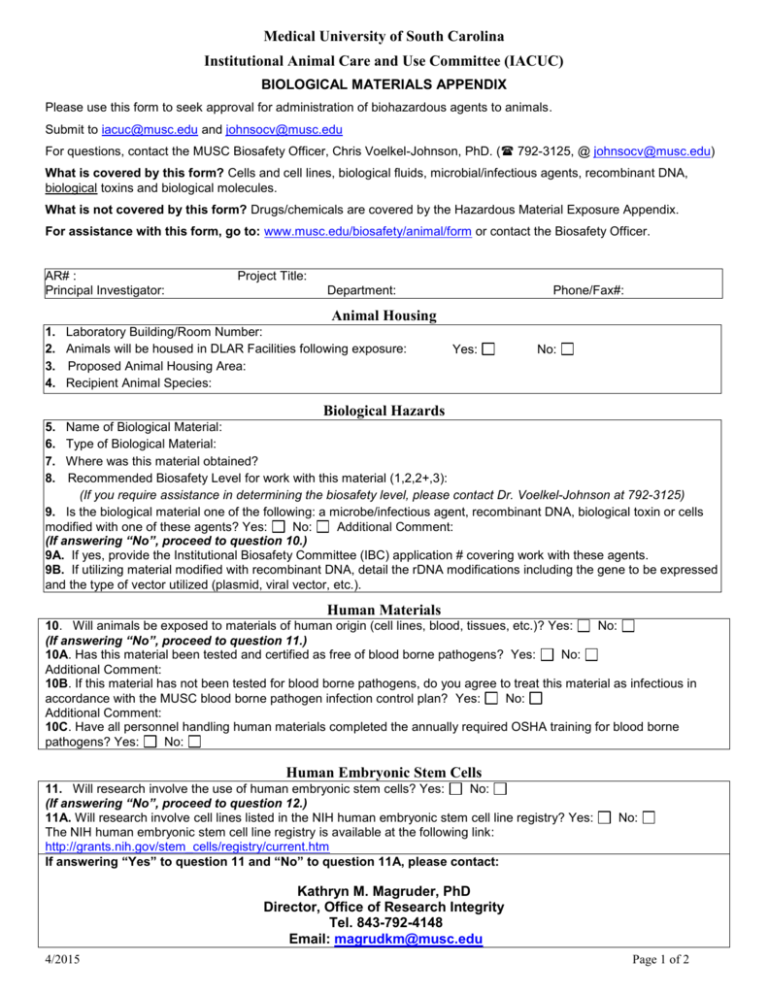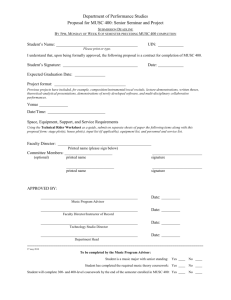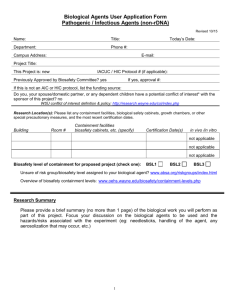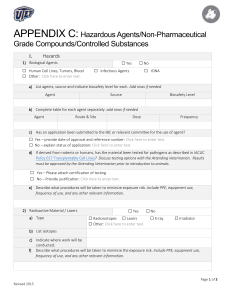Biological Materials Appendix - Medical University of South Carolina
advertisement

Medical University of South Carolina Institutional Animal Care and Use Committee (IACUC) BIOLOGICAL MATERIALS APPENDIX Please use this form to seek approval for administration of biohazardous agents to animals. Submit to iacuc@musc.edu and johnsocv@musc.edu For questions, contact the MUSC Biosafety Officer, Chris Voelkel-Johnson, PhD. ( 792-3125, @ johnsocv@musc.edu) What is covered by this form? Cells and cell lines, biological fluids, microbial/infectious agents, recombinant DNA, biological toxins and biological molecules. What is not covered by this form? Drugs/chemicals are covered by the Hazardous Material Exposure Appendix. For assistance with this form, go to: www.musc.edu/biosafety/animal/form or contact the Biosafety Officer. AR# : Principal Investigator: Project Title: Department: Phone/Fax#: Animal Housing 1. 2. 3. 4. Laboratory Building/Room Number: Animals will be housed in DLAR Facilities following exposure: Proposed Animal Housing Area: Recipient Animal Species: Yes: No: Biological Hazards 5. 6. 7. 8. Name of Biological Material: Type of Biological Material: Where was this material obtained? Recommended Biosafety Level for work with this material (1,2,2+,3): (If you require assistance in determining the biosafety level, please contact Dr. Voelkel-Johnson at 792-3125) 9. Is the biological material one of the following: a microbe/infectious agent, recombinant DNA, biological toxin or cells modified with one of these agents? Yes: No: Additional Comment: (If answering “No”, proceed to question 10.) 9A. If yes, provide the Institutional Biosafety Committee (IBC) application # covering work with these agents. 9B. If utilizing material modified with recombinant DNA, detail the rDNA modifications including the gene to be expressed and the type of vector utilized (plasmid, viral vector, etc.). Human Materials 10. Will animals be exposed to materials of human origin (cell lines, blood, tissues, etc.)? Yes: No: (If answering “No”, proceed to question 11.) 10A. Has this material been tested and certified as free of blood borne pathogens? Yes: No: Additional Comment: 10B. If this material has not been tested for blood borne pathogens, do you agree to treat this material as infectious in accordance with the MUSC blood borne pathogen infection control plan? Yes: No: Additional Comment: 10C. Have all personnel handling human materials completed the annually required OSHA training for blood borne pathogens? Yes: No: Human Embryonic Stem Cells 11. Will research involve the use of human embryonic stem cells? Yes: No: (If answering “No”, proceed to question 12.) 11A. Will research involve cell lines listed in the NIH human embryonic stem cell line registry? Yes: The NIH human embryonic stem cell line registry is available at the following link: http://grants.nih.gov/stem_cells/registry/current.htm If answering “Yes” to question 11 and “No” to question 11A, please contact: No: Kathryn M. Magruder, PhD Director, Office of Research Integrity Tel. 843-792-4148 Email: magrudkm@musc.edu 4/2015 Page 1 of 2 Medical University of South Carolina Institutional Animal Care and Use Committee (IACUC) Pathogen Testing of Cell Lines and Biological Materials Used in Rodents This section is intended to ensure compliance with the MUSC IACUC rodent pathogen testing policy: http://research.musc.edu/ori/iacuc/po_cells.html 12. Will animals be exposed to materials of rodent origin or other biological materials that have been previously used in animals? Yes: No: (If answering “No”, proceed to question 16.) 13. Is this biological material of rodent origin? Yes: No: Additional comment: 14. Has this material been previously passaged through live rodents or exposed to any products of rodent origin? If “Yes”, please describe. Yes: No: Additional Comment: 15. Has this material been previously administered to animals in DLAR facilities? Yes: No: 15A. If yes, how long were the recipient animals kept alive following exposure to the material? Less than three months: Three months or more: Additional Comment: 15B. Did animals exhibit any pathology following exposure to this material? Yes: No: Additional Comment: 16. Has this material been PCR, MAP, or RAP tested for rodent pathogens? Yes: No: Additional Comment: Procedures 17. Describe the procedure involving the biohazardous material to be performed in animals (Include route/method of administration, volume and concentration). 18. What type of restraint or anesthesia will be used to control the animal while administering the material? 19. Will procedures be performed in a biosafety cabinet to contain aerosols? Yes: No: 20. What type of personal protective equipment will be used while administering the material and working with animals exposed to the material? 21. Will toxins or infectious agents be shed or excreted by animals upon administration? Yes: No: 22. If yes, please describe the route of shedding/excretion and length of time it is expected to occur. 23. How will the material and associated waste be neutralized, deactivated or decontaminated? 24. How will animal carcasses exposed to the material be disposed? 25. Will any special precautions need to be utilized for work with animals treated with these materials? (e.g., disposable cages, no other projects housed in the same room, vaccination, personnel protective equipment, waste disposal procedures, personnel precautions, etc.) 26. I certify that I am responsible for the conduct of work at Biosafety Level and have informed all associated personnel of the conditions of this work. I further understand that I am responsible for training all personnel coming into contact with this agent and/or animals to which the agent has been administered. All personnel on this project will have this agent identified to Employee Health Services on their annual health survey form. 27. A) Signature of PI Date B) Signature of Biosafety Officer Test results required for protocol release: Yes: 4/2015 Date No: Page 2 of 2




